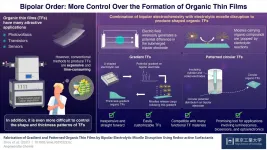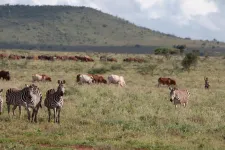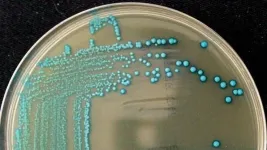Bone marrow disorder nearly 10-times more common in those with venom allergy
It started as a quality assurance project by allergy residents; it became the most comprehensive venom allergy study in the country
2021-05-18
(Press-News.org) Researchers at Michigan Medicine found that people with venom allergies are much more likely to suffer mastocytosis, a bone marrow disorder that causes higher risk of fatal reactions.
The team of allergists examined approximately 27 million United States patients through an insurance database - easily becoming the nation's largest study of allergies to bee and wasp stings, or hymenoptera venom. The results, published in the Journal of Allergy and Clinical Immunology, revealed mastocytosis in fewer than 0.1% of venom allergy patients - still near 10 times higher than those without allergies.
"Even though there is mounting interest, mast cell diseases are quite understudied; there are probably many people who go through life as some sort of 'medical mystery,' unaware of that diagnosis," says lead investigator Charles Schuler, M.D., a clinical assistant professor of allergy and immunology at Michigan Medicine. "One way to find them is to find people with a venom allergy. This research strongly supports that and will help us more properly treat these patients."
A life-threatening reaction to a bee sting can often be the first manifestation of mastocytosis. It's the most common anaphylaxis trigger in that patient population.
While mastocytosis diagnoses are more prevalent in U.S. venom allergy patients, the numbers are significantly higher in Europe, says Cem Akin, M.D., senior author and clinical professor of allergy and immunology at Michigan Medicine.
"This suggests that there may be differences in sensitization patterns to bee and wasp venoms between Europe and the U.S.," Akin says. "However, the European numbers may be overestimated due to referral and patient selection bias, as most of the centers publishing on the topic are referral facilities for mastocytosis. While Michigan Medicine is one of the world's largest referral centers for mastocytosis, we also have a large population of patients we follow for venom allergy."
The study included a five-year analysis of patients with history of severe venom allergy who underwent venom desensitization immunotherapy at Michigan Medicine. The research team found that elevated levels of tryptase, a chemical secreted by allergy cells, may predict if a person is at higher risk for reaction to immunotherapy.
"This study helps us account for the side effects or adverse outcomes associated with our current therapy," Schuler says. "Knowing this, allergists can be more watchful during sessions and watch for systemic reactions."
This study started out as a Michigan Medicine quality assurance project, and the paper is now the most comprehensive analysis of incidence of hymenoptera venom allergy and mastocytosis in the country, says James Baldwin, M.D., chief of Michigan Medicine's division of allergy and clinical immunology.
"It creates a picture of the burden of these conditions," Baldwin says. "It will inform both future research and public policy decisions in the field moving forward."
INFORMATION:
Disclosures: Dr. Schuler reports salary and other support from the Mary H. Weiser Food Allergy Center and the Taubman Innovation Institute at U-M; he has also received sponsored project support from Healgen Scientific and Access Bio Inc. for unrelated projects.
Paper cited: "Prevalence of mastocytosis and hymenoptera venom allergy in the United States," The Journal of Allergy and Clinical Immunology. DOI: 10.1016/j.jaci.2021.04.013
ELSE PRESS RELEASES FROM THIS DATE:
2021-05-18
Modern and emerging applications in various fields have found creative uses for organic thin films (TFs); some prominent examples include sensors, photovoltaic systems, transistors, and optoelectronics. However, the methods currently available for producing TFs, such as chemical vapor deposition, are expensive and time-consuming, and often require highly controlled conditions. As one would expect, making TFs with specific shapes or thickness distributions is even more challenging. Because unlocking this customizability could spur advances in many sophisticated applications, researchers are actively exploring new approaches for ...
2021-05-18
In quiet moments, the brain likes to wander—to the events of tomorrow, an unpaid bill, an upcoming vacation.
Despite little external stimulation in these instances, a part of the brain called the default mode network (DMN) is hard at work. "These regions seem to be active when people aren't asked to do anything in particular, as opposed to being asked to do something cognitively," says Penn neuroscientist Joseph Kable.
Though the field has long suspected that this neural network plays a role in imagining the future, precisely how it works hadn't been fully understood. Now, research from Kable and two former graduate students in his lab, Trishala Parthasarathi, associate director of scientific services at OrtleyBio, and Sangil Lee, a postdoc at University of California, ...
2021-05-18
SAN DIEGO (May TK, 2021) - Compared to most other bear species, very little is known about how female Andean bears choose where they give birth to cubs. As a critical component of the reproductive cycle, birthing dens are essential to the survival of South America's only bear species, listed as Vulnerable on the International Union for Conservation of Nature (IUCN) Red List of Threatened Species.
A new study led by Russ Van Horn, Ph.D., published April in the journal Ursus, takes the most detailed look yet at the dens of this species. Van Horn, a population sustainability scientist, leads San Diego Zoo Wildlife Alliance's Andean bear conservation program. He was joined by colleagues from the University of British Columbia's Department of Forest ...
2021-05-18
A large survey of women in California shows significant racial and ethnic differences in the types of personal care products women use on a daily basis. Because many personal care products contain endocrine disrupting chemicals (EDCs) like parabens and phthalates that interfere with the body's hormones, the findings could shed light on how different products influence women's exposures to harmful chemicals that contribute to health inequities.
The study appears in the Journal of Exposure Science & Environmental Epidemiology as part of a special issue focused on health equity. ...
2021-05-18
In the midst of a devastating global pandemic of wildlife origin and with future spillovers imminent as humans continue to come into closer contact with wildlife, infectious-disease models that consider the full ecological and anthropological contexts of disease transmission are critical to the health of all life. Existing models are limited in their ability to predict disease emergence, since they rarely consider the dynamics of the hosts and ecosystems from which pandemics emerge.
Published May 17 in Nature Ecology and Evolution, Smithsonian scientists and partners provide a framework for a new approach to modeling infectious diseases. It adapts established methods developed to study the planet's natural systems, including ...
2021-05-18
LA JOLLA--(MAY 18, 2021) Despite only accounting for about 1 percent of skin cancers, melanoma causes the majority of skin cancer-related deaths. While treatments for this serious disease do exist, these drugs can vary in effectiveness depending on the individual.
A Salk study published on May 18, 2021, in the journal Cell Reports reveals new insights about a protein called CRTC3, a genetic switch that could potentially be targeted to develop new treatments for melanoma by keeping the switch turned off.
"We've been able to correlate the activity of this genetic switch to melanin production and cancer," says Salk study ...
2021-05-18
Nearly 15 percent of the U.S. population experiences migraine. One subtype of migraine that is not well understood is migraine with aura (MA). Individuals who experience MA often see flashing lights, blind spots, or jagged lines in their visual field prior to onset of their migraine headaches. Individuals who experience MA also face a heightened risk of stroke and cardiovascular disease, although scientists continue to explore why this correlation exists. In a new study from Brigham and Women's Hospital, researchers used a technique in genetic analysis termed Mendelian randomization to examine 12 coagulation measures, uncovering four that are associated ...
2021-05-18
For the first time, researchers can quantitatively predict blood flow conditions that likely cause pathological behavior of the human blood protein von Willebrand factor (vWF). Predictions from this new method of simulation, developed at Lehigh University, can be used to optimize the design of the mechanical pumps known as left ventricular assist devices used in heart failure patients. The method also has the potential to improve diagnosis and treatment of von Willebrand disease, the most common inherited bleeding disorder in the U.S., according to the Centers for Disease Control and Prevention. The article, "Predicting pathological von Willebrand factor unraveling in elongational flow," appears ...
2021-05-18
A new study of ancient DNA from horse fossils found in North America and Eurasia shows that horse populations on the two continents remained connected through the Bering Land Bridge, moving back and forth and interbreeding multiple times over hundreds of thousands of years.
The new findings demonstrate the genetic continuity between the horses that died out in North America at the end of the last ice age and the horses that were eventually domesticated in Eurasia and later reintroduced to North America by Europeans. The study has been accepted for publication in the journal Molecular Ecology and is currently available ...
2021-05-18
ITHACA, N.Y. - While examining the prevalence of listeria in agricultural soil throughout the U.S., Cornell University food scientists have stumbled upon five previously unknown and novel relatives of the bacteria.
The discovery, researchers said, will help food facilities identify potential growth niches that until now, may have been overlooked - thus improving food safety.
"This research increases the set of listeria species monitored in food production environments," said lead author Catharine R. Carlin, a doctoral student in food science. "Expanding the knowledge base to understand the diversity of listeria will save the commercial food world confusion and errors, as well as prevent ...
LAST 30 PRESS RELEASES:
[Press-News.org] Bone marrow disorder nearly 10-times more common in those with venom allergy
It started as a quality assurance project by allergy residents; it became the most comprehensive venom allergy study in the country



